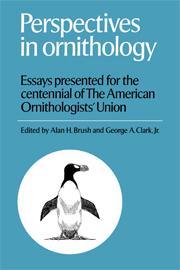 Perspectives in Ornithology
Perspectives in Ornithology Book contents
- Frontmatter
- Contents
- List of contributors
- Preface
- Introduction
- 1 Captive birds and conservation
- 2 Research collections in ornithology – a reaffirmation
- 3 On the study of avian mating systems
- 4 Cooperative breeding strategies among birds
- 5 Ecological energetics: what are the questions?
- 6 Perspectives in optimal foraging
- 7 Biochemical studies of microevolutionary processes
- 8 Organization of the avian genome
- 9 The origin and early radiation of birds
- 10 Avian community ecology: an iconoclastic view
- 11 Biogeography: the unification and maturation of a science
- 12 Bird song learning: theme and variations
- 13 Bird navigation
- Index
11 - Biogeography: the unification and maturation of a science
Published online by Cambridge University Press: 04 August 2010
- Frontmatter
- Contents
- List of contributors
- Preface
- Introduction
- 1 Captive birds and conservation
- 2 Research collections in ornithology – a reaffirmation
- 3 On the study of avian mating systems
- 4 Cooperative breeding strategies among birds
- 5 Ecological energetics: what are the questions?
- 6 Perspectives in optimal foraging
- 7 Biochemical studies of microevolutionary processes
- 8 Organization of the avian genome
- 9 The origin and early radiation of birds
- 10 Avian community ecology: an iconoclastic view
- 11 Biogeography: the unification and maturation of a science
- 12 Bird song learning: theme and variations
- 13 Bird navigation
- Index
Summary
One may define biogeography as the geographic arrangement of living organisms, the history of how a particular arrangement is achieved, and an analysis of possible reasons for the arrangement. Biogeography thus overlaps broadly with ecology (as defined by Krebs 1978) and with large sections of systematics, paleontology, and geology. These overlaps are mirrored in a schism between historical biogeography and ecological biogeography, the former grounded in evolutionary systematics and the earth sciences, the latter in ecology. Literatures in the two traditions are largely separate, and Rosen (1978) feels that this schism is inevitable and likely permanent. I predict that the differences between the two approaches will lessen. They are more a function of different foci: long time frames and large geographic scales for historical biogeography and short periods and local geography for ecological biogeography (Simberloff et al. 1981). Furthermore, a complete understanding of current biogeographical patterns requires both approaches, and I feel that the two traditions are beset by the same main problem: frequent absence of falsifiable hypotheses and of statistical tests that can help to choose between competing theories. Ball (1975) suggests that all sciences pass through a descriptive stage (when patterns are noted), a narrative stage (when explanations are proposed for the patterns but are simply coherent narratives), and an analytical stage (in which competing hypotheses are rigorously tested) and that biogeography is on the threshold of the analytical stage.
- Type
- Chapter
- Information
- Perspectives in OrnithologyEssays Presented for the Centennial of the American Ornitholgists' Union, pp. 411 - 474Publisher: Cambridge University PressPrint publication year: 1983
- 8
- Cited by


